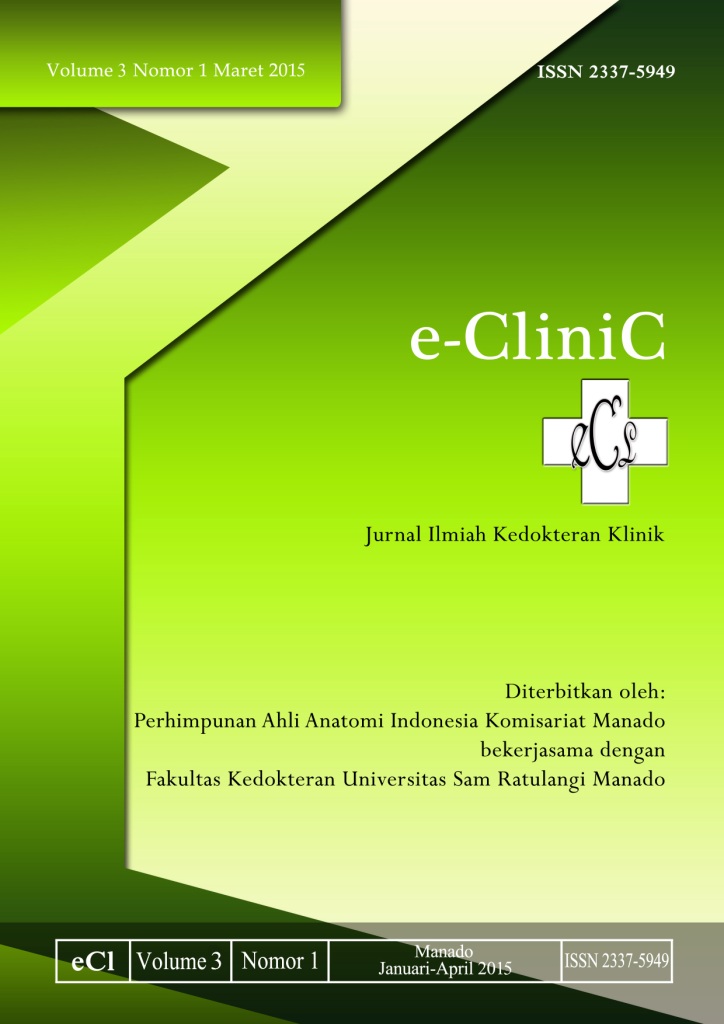PERBANDINGAN TEKANAN DARAH ANTARA ANAK YANG TINGGAL DI PEGUNUNGAN DAN PESISIR PANTAI
DOI:
https://doi.org/10.35790/ecl.v3i1.6425Abstract
Abstract: Blood pressure in children varies because there are many factors that influence. One is geographic factors. Based on data from the Health Research in 2007 found that the prevalence of hypertension is highest in coastal areas while the lowest prevalence of hypertension in the coastal area. Altitude and different sodium intake on mountain and coastal areas are assumed to affect the blood pressure. This study aimed to determine the difference in blood pressure between children who live in the mountains and in the coast. We used descriptive analytic method with cross sectional design, with 107 samples according to criteria of children aged 6-12 years with no family history of obesity and hypertension. Data were obtained by using questionnaire, measurement of weight and height (BMI) and blood pressure measurement using a sphygmomanometer and cuff child. The results showed 15.5% of children with high-normal systolic pressure and 17.4% of children with high diastolic pressure in the mountains. In coastal areas, found 28% of children with normal systolic pressure-high, 13% of children of normal-high diastolic pressure, and 5% of children of high diastolic pressure. These data were analyzed using Mann Whitney test, showing the results were not statistically significantly systolic (p = 0.815) diastolic (p = 0.221) so that H0 and H1 is rejected. Conclusion: There was no difference in blood pressure among children aged 6-12 years who live in the mountains and the coast.
Keywords: child's blood pressure, mountains, coastal.
Abstrak: Tekanan darah pada anak bervariasi karena ada banyak faktor yang memengaruhi. Salah satunya adalah faktor geografis. Berdasarkan data Riset Kesehatan Dasar tahun 2007 didapatkan prevalensi hipertensi tertinggi di wilayah pantai sedangkan prevalensi hipertensi terendah di wilayah pantai. Ketinggian lokasi dan asupan natrium yang berbeda pada daerah pegunungan dan pesisir pantai diasumsikan berpengaruh terhadap tekanan darah. Penelitian ini bertujuan untuk mengetahui perbedaan tekanan darah antara anak yang tinggal di pegunungan dan pesisir pantai. Metode penelitian deskriptif analitik dengan rancangan potong lintang, dengan 107 sampel sesuai kriteria anak umur 6-12 tahun tanpa obesitas dan riwayat keluarga hipertensi. Data diperoleh melalui kuesioner, pengukuran berat badan dan tinggi badan (IMT) dan pengukuran tekanan darah menggunakan sphygmomanometer dan manset anak. Hasil penelitian menunjukkan 15,5% anak dengan tekanan sistolik normal-tinggi dan 17,4% anak dengan tekanan diastolik tinggi pada daerah pegunungan. Pada daerah pesisir pantai ditemukan 28% anak dengan tekanan sistolik normal-tinggi, 13% anak tekanan diastolik normal-tinggi, dan 5% anak tekanan diastolik tinggi. Data ini dianalisis menggunakan uji mann whitney, menunjukkan hasil secara statistik tidak bermakna sistolik (p=0,815) diastolik (p=0,221) sehingga H0 diterima dan H1 ditolak. Simpulan: Tidak ada perbedaan tekanan darah antara anak berumur 6-12 tahun yang tinggal di pegunungan dan pesisir pantai.
Kata kunci: tekanan darah anak, pegunungan, pantai.
Downloads
Published
How to Cite
Issue
Section
License
COPYRIGHT
Authors who publish with this journal agree to the following terms:
Authors hold their copyright and grant this journal the privilege of first publication, with the work simultaneously licensed under a Creative Commons Attribution License that permits others to impart the work with an acknowledgment of the work's origin and initial publication by this journal.
Authors can enter into separate or additional contractual arrangements for the non-exclusive distribution of the journal's published version of the work (for example, post it to an institutional repository or publish it in a book), with an acknowledgment of its underlying publication in this journal.
Authors are permitted and encouraged to post their work online (for example, in institutional repositories or on their website) as it can lead to productive exchanges, as well as earlier and greater citation of the published work (See The Effect of Open Access).







